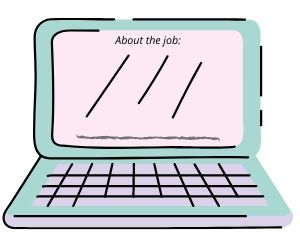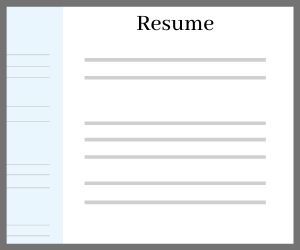You’ve worked for several years to develop different skills. You’ve been a leader in an array of positions. Your background is varied, but you have a lot to offer.

You ‘ve searched job postings and see several in different capacities that might be a perfect match for you. So how do you get in front of the decision-makers to sell your abilities?
There are an enormous amount of career counselling and resume-writing firms anxious to provide tips on getting an interview, one of the few spots on a calendar that enable job seekers to explain why they’re a fit for the job. But with over fifteen years working with job seekers in many different industries, there are 6 major mistakes that job seekers make that keep them from landing the interview:
- Not fully reading the job profile
- Not researching the company
- Not tailoring the resume to fit the job
- Not proofreading resume and correcting errors
- Writing a poor cover letter
- No follow-up
Let’s take a look at each of these, but in an effort to be uplifting and positive, we’ll focus on what should be done, instead of mistakes. Here we go…
1.) Fully read the job profile

Quite frequently, job seekers skim a job profile on a job board somewhere, get excited about the potential fit, but never completely read what the company has written regarding the requirements for the job. Many HR representatives know this; did you know that it’s not uncommon for companies to ask applicants to do specific things within the body of the job description somewhere in the job profile? Whether the person writing the job specifications utilizes this tactic to weed out people who don’t follow instructions, or if they use it at all isn’t the point. The point is that the company has chosen to use that job profile to explain to the world what they’re seeking and they expect prospective applicants to read it.
Another reason to fully read their job description is to gain the best understanding about the skills needed, and what personal characteristics the company holds to be most important to be successful in the job.
2.) Research the company
It’s quite easy to forego researching companies behind jobs, especially if you’re applying for many different positions. Applicants often figure that they’re most likely not going to hear back regarding many of their applications, so the sentiment is “why bother,” or at least why bother until they show some interest.
The bigger point here is that the company is looking for the best, long-term (most of the time) match. They want to hire someone whose skill sets are a good fit, but also someone who’s assertive about learning about the company and shows that they’re excited about the possibility of working there.
Researching the company before applying enables you to interject some knowledge of the company in your cover letter, and it could even help you in detailing how you might be a good fit with the company’s overall mission.
3.) Tailor your resume for the job
Preparing a resume means crafting a representation of your true skills and abilities that are in line with what they seek. Tailoring your resume to fit the job for which you’re applying DOES NOT imply lying, or stretching the truth in any way. It simply means to take steps to clearly show how your skill sets are a match with the skills they seek.

In the past, it was likely Human Resources representatives who would comb through resumes looking for specific skills that might translate well to the job they were filling.
Terms in different segments of different industries vary, even though the skills used might be parallel. As an applicant, it’s your job to make the reader see how your true skill sets would translate for the particular job for which you’re applying. Highlight skills that you have that they’re seeking, while it might also make sense to de-emphasize or omit skills that would not apply.
Today, AI is being used more and more to sort resumes of applicants. Key skills are emphasized, and if those skills are present on the resume, that resume may go into the stack titled, ‘review further.” But what if your skills are just represented with similar, (but not identical) wording on your resume? What if the language that you use and the language the company uses mean the same thing, but are stated differently?
Use the requirements stated on the job profile to tailor the wording of the experiences that you have had which match what they seek so that, as much as possible, ambiguity through different terms is eliminated.
If you’re applying for multiple jobs with different requirements, make different versions of your resume that allow you to highlight your most relevant skills and experiences for each position.
4.) PROOFREAD
I have seen many, many occasions where a resume of an otherwise well-qualified individual was eliminated from consideration because they had errors.
A resume is the first impression of your life experiences. If an individual cares so little about their own self-presentation that they don’t bother to catch and correct simple typos and spelling errors, might that be an indication of how they would perform on the job? Maybe. Maybe not. But at the resume-submission stage of the application process, those reviewing resumes have little else to evaluate.
Always, ALWAYS, ALWAYS, read through your own resume several times to check for and correct errors. Then, have someone close to you read it, as well. (You might be surprised what another set of eyes can still find after you’ve read it several times!)
Proofreading also entails checking the layout for ease of reading. Does the layout make it easy for someone to find key skills? Is there redundancy? Is the color scheme pleasing? Are there enough separations (like paragraphs) or segments to make it easy to skim? Do you use the same tense throughout your resume? Is punctuation correct? These are all things that you should evaluate prior to submitting your resume.
5.) Write a compelling cover letter
Cover letters (or some may call them an application letter) are often the very first opportunity to introduce yourself to representative of a company that you are interested in joining. Make it great.
Cover letters should be succinct and compelling. They should make the reader want to learn more about you, but they should be aimed at explaining how YOU are a great fit for the job they have to fill.
Depending on the person reviewing applicants, cover letters either get read word for word, they get skimmed, or aren’t even reviewed at all. Yet, a cover letter should always accompany an application and resume. It is a professional introduction of how you can help solve a problem that the company has; that problem is that they have a job that needs to be filled with a person who has the skills to get the work done.
In a cover letter, focus on the company. (After all, in the mind of the person reviewing applicants, the job opening is all about the company and filling a need, not about you.)
Proofread it, ensuring it is written correctly.
If you choose to state you’ll follow up, make sure you do. NOT doing what you say you will in a cover letter may go unnoticed, but it also may be a sign to the reader that you lack integrity.
This leads to the final point…
6.) Follow-up
Depending on the market, the job, and the company, the person (or people) reviewing applications may be barraged with people wanting to be considered for the position. Even so, their business continues, often with others having to fill in to accomplish their own duties as well as the duties of job to be filled. They are busy! Because of this, many times, those who are assertive about getting in front of decision-makers get the interview.
Be polite. Be professional. But get your name in front of them. Inquire about the status of the application process and whether they’ve had the opportunity to review your credentials. If given the opportunity (like on a phone call), explain your interest in the position and company and how you can help them.
Following up can also mean utilizing your network. Do you know anyone who currently works for the company which has posted the job? Are you connected with anyone on LinkedIn who works there? Inquire with them. Let them know you’ve applied. Often, companies have referral programs and acquaintances may be very willing to put in a good word for you, especially if they might get a bonus if you’re hired.
Follow-up can be the difference between getting an interview and getting passed over; however, discernment is key. Too much follow-up or a lack of diplomacy can go against your favor.
Summary
If you do all of these things, does it ensure you’ll be getting the interview? Of course not. Let’s face it: sometimes it’s a matter of timing; someone else with the skills the company needs gets in front of them first. Sometimes, a position is posted even though the organization already has a person in mind for the position. Sometimes, someone else is just a great fit, or your presentation of your skills just didn’t resonate with the resume reviewer.
But doing these things, and doing them well, will set you up for the most likelihood for success, and sooner or later… that perfect job might just become yours!

